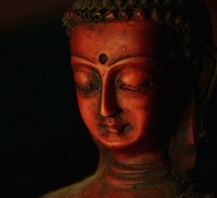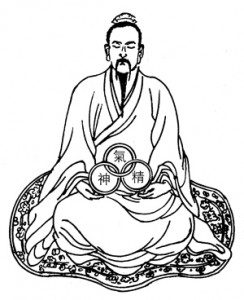TYPES OF MEDITATION
Ok, so you know that meditation has dozens of benefits and everybody is doing it. You look for information online or on a bookstore, and see that there area LOT of different ways of doing meditation, dozens of meditation techniques, and some conflicting information. You wonder which way is best for you.
This article will help you navigate the sea of different practices of seated meditation, briefly explaining each of them, and pointing to further resources. There are literally hundreds – if not thousands – of types of meditation, so here I will explore only the most popular ones.
GENERAL TYPES
Scientists usually classify meditation based on the way they focus attention, into two categories: Focused Attention and Open Monitoring. I’d like to propose a third: Effortless Presence.
Focused attention meditation – Focusing the attention on a single object during the whole meditation session. This object may be the breath, a mantra, visualization, part of the body, external object, etc. As the practitioner advances, his ability to keep the flow of attention in the chosen object gets stronger, and distractions become less common and short-lived. Both the depth and steadiness of his attention are developed.
Examples of these are: Samatha (Buddhist meditation), some forms of Zazen, Loving Kindness Meditation, Chakra Meditation, Kundalini Meditation, Sound Meditation, Mantra Meditation, Pranayama, some forms of Qigong, and many others.
Open monitoring meditation – Instead of focusing the attention on any one object, we keep it open, monitoring all aspects of our experience, without judgment or attachment. All perceptions, be them internal (thoughts, feelings, memory, etc.) or external (sound, smell, etc.), are recognized and seen for what they are. It is the process of non-reactive monitoring of the content of experience from moment to moment, without going into them. Examples are: Mindfulness meditation, Vipassana, as well as some types of Taoist Meditation.
Effortless Presence – It’s the state where the attention is not focused on anything in particular, but reposes on itself – quiet, empty, steady, and introverted. We can also call it “Choiceless Awareness” or “Pure Being”. Most of the meditation qoutes you find speak of this state.
This is actually the true purpose behind all kinds of meditation, and not a meditation type in itself. All traditional techniques of meditation recognize that the object of focus, and even the process of monitoring, is just a means to train the mind, so that effortless inner silence and deeper states of consciousness can be discovered. Eventually both the object of focus and the process itself is left behind, and there is only left the true self of the practitioner, as “pure presence”.
In some techniques, this is the only focus, from the beginning. Examples are: the Self-Enquiry (“I am” meditation) of Ramana Maharishi; Dzogchen; Mahamudra; some forms of Taoist Meditation; and some advanced forms of Raja Yoga. In my point of view, this type of meditation always requires previous training to be effective, even though this is sometimes not expressly said (only implied).
1) BUDDHIST MEDITATION
Zen Meditation (Zazen)
Zazen (坐禅) means “seated Zen”, or “seated meditation”, in Japanese. It has its roots in the Chinese Zen Buddhism (Ch’an) tradition, tracing back to Indian monk Bodhidharma (6th century CE). In the West, its most popular forms comes from Dogen Zenji (1200~1253), the founder of Soto Zen movement in Japan. Similar modalities are practiced in theRinzai school of Zen, in Japan and Korea.
Vipassana Meditation
“Vipassana” is a Pali word tha t means “insight” or “clear seeing”. It is a traditional Buddhist practice, dating back to 6th century BC. Vipassana-meditation, as taught in the last few decades, comes from the Theravada Buddhist tradition, and was popularized by S. N. Goenka and theVipassana movement.
t means “insight” or “clear seeing”. It is a traditional Buddhist practice, dating back to 6th century BC. Vipassana-meditation, as taught in the last few decades, comes from the Theravada Buddhist tradition, and was popularized by S. N. Goenka and theVipassana movement.
Due to the popularity of Vipassanā-meditation, the “mindfulness of breathing” has gained further popularity in the West as “mindfulness”.
Mindfulness Meditation
Mindfulness Meditation is an adaptation from traditional Buddhist meditation practices, especially Vipassana, but also having strong influence from other lineages (such as the Vietnamese Zen Buddhism fromThich Nhat Hanh). “Mindfulness” is the common western translation for the Buddhist term sati. Anapanasati, “mindfulness of breathing”, is part of the Buddhist practice of Vipassana or insight meditation, and other Buddhist meditational practices, such as zazen (source: Wikipedia).
One of the main influencers for Mindfulness in the West isJohn Kabat-Zinn. His Mindfulness-Based Stress Reduction program (MBSR) – which he developed in 1979 at the University of Massachusetts Medical School – has been used in several hospitals and health clinic on the past decades.
Loving Kindness Meditation (Metta Meditation)
 Metta is a Pali word that means kindness, benevolence, and good will. This practice comes from the Buddhist traditions, especially1the Theravada and Tibetan lineages. “Compassion meditation” is a contemporary scientific field that demonstrates the efficacy of metta and related meditative practices.
Metta is a Pali word that means kindness, benevolence, and good will. This practice comes from the Buddhist traditions, especially1the Theravada and Tibetan lineages. “Compassion meditation” is a contemporary scientific field that demonstrates the efficacy of metta and related meditative practices.
Demonstrated benefits include: boosting one’s ability to empathize with others; development of positive emotions through compassion, including a more loving attitude towards oneself; increased self-acceptance; greater feeling of competence about one’s life; and increased feeling of purpose in life.
“For one who attends properly to the liberation of the heart by benevolence, unarisen ill will does not arise and arisen ill will is abandoned.” – The Buddha
2) HINDU MEDITATION (Vedic & Yogic)
Mantra Meditation (OM Meditation)
 A mantra is a syllable or word, usually without any particular meaning, that is repeated for the purpose of focusing your mind. It isnot an affirmation used to convince yourself of something.
A mantra is a syllable or word, usually without any particular meaning, that is repeated for the purpose of focusing your mind. It isnot an affirmation used to convince yourself of something.
Some meditation teachers insist that both the choice of word, and its correct pronunciation, is very important, due to the “vibration” associated to the sound and meaning, and that for this reason an initiation into it is essential. Others say that the mantra itself is only a tool to focus the mind, and the chosen word is completely irrelevant.
Mantras are used in Hindu traditions, Buddhist traditions (especially Tibetan and “Pure Land” Buddhism), as well as in Jainism, Sikhism and Daoism (Taoism). Some people call mantra meditation “om meditation”, but that is just one of the mantras that can be used. A more devotion oriented practice of mantras is called japa, and consists of repeating sacred sounds (name of God) with love.
“As you repeat the mantra, it creates a mental vibration that allows the mind to experience deeper levels of awareness. As you meditate, the mantra becomes increasingly abstract and indistinct, until you’re finally led into the field of pure consciousness from which the vibration arose.
Repetition of the mantra helps you disconnect from the thoughts filling your mind so that perhaps you may slip into the gap between thoughts. The mantra is a tool to support your meditation practice. Mantras can be viewed as ancient power words with subtle intentions that help us connect to spirit, the source of everything in the universe”. – (Deepak Chopra)
Transcendental Meditation (TM)
Transcendental Meditation is a specific form of Mantra Meditation introduced by Maharishi Mahesh Yogi in 1955 in India and the West. In the late 1960s and early 1970s, the Maharishi achieved fame as the guru to the Beatles, The Beach Boys and other celebrities.
It is a widely practiced form of meditation, with over 5 million practitioners worldwide, and there is a lot of scientific research, many sponsored by the organization, demonstrating the benefits of the practice. There are over 600 scientific papers, many of them peer-reviewed, and I have used part of their research when composing my benefits of meditation page. However, there are also critics of the Maharishi and his organization, and some accusation of cultish behavior and doubtful research practices.
Yoga Meditations
 There is not one type of meditation which is “Yogic Meditation”, so here it is meant the several meditation types taught in the yoga tradition. Yoga means “union”. Tradition goes as far as 1700 B.C, and has as its highest goal spiritual purification and Self-Knowledge. Classical Yoga divides the practice into rules of conduct (yamas andniyamas), physical postures (asanas), breathing exercises (pranayama), and contemplative practices of meditation (pratyahara, dharana, dhyana, samadhi).
There is not one type of meditation which is “Yogic Meditation”, so here it is meant the several meditation types taught in the yoga tradition. Yoga means “union”. Tradition goes as far as 1700 B.C, and has as its highest goal spiritual purification and Self-Knowledge. Classical Yoga divides the practice into rules of conduct (yamas andniyamas), physical postures (asanas), breathing exercises (pranayama), and contemplative practices of meditation (pratyahara, dharana, dhyana, samadhi).
Self-Enquiry and “I Am” Meditation
Self-Enquiry is the English translation for the Sanskrit term atma vichara. It means to “investigate” our true nature, to find the answer to the “Who am I?” question, which culminates with the intimate knowledge of our true Self, our true being. We see references to this meditation in very old Indian texts; however, it was greatly popularized and expanded upon by the 20th-century Indian sage Ramana Maharshi (1879~1950).
The modern non-duality movement (or neo-advaita), which is greatly inspired in his teachings – as well as those ofNisargadatta Maharaj (1897~1981) and Papaji – strongly uses this technique and variations. Many contemporary teachers to employ this technique, the most famous ones being Mooji (whom I’ve personally been with and recommend), Adyashanti, and Eckhart Tolle.
3) CHINESE MEDITATION
Taoist Meditations
 Daoism is a Chinesephilosophy and religion, dating back to Lao Tzu (or Laozi). It emphasizes living in harmony with Nature, or Tao, and it’s main text is the Tao Te Ching, dating back to 6th century B.C. Later on some lineages of Taoism were also influenced by Buddhist meditation practices brought from India, especially on the 8th century C.E..
Daoism is a Chinesephilosophy and religion, dating back to Lao Tzu (or Laozi). It emphasizes living in harmony with Nature, or Tao, and it’s main text is the Tao Te Ching, dating back to 6th century B.C. Later on some lineages of Taoism were also influenced by Buddhist meditation practices brought from India, especially on the 8th century C.E..
The chief characteristic of this type of meditation is the generation, transformation, and circulation of inner energy. The purpose is to quieten the body and mind, unify body and spirit, find inner peace, and harmonize with the Tao. Some styles of Taoist Meditation are specifically focused on improving health and giving longevity.
Qigong (Chi kung)
Qigong (also spelled chi kung, or chi gung) is a Chinese word that means “life energy cultivation”, and is a body-mind exercise for health, meditation, and martial arts training. It typically involves slow body movement, inner focus, and regulated breathing. Traditionally it was practiced and taught in secrecy in the Chinese Buddhist, Taoist and Confucianist traditions. In the 20th century, Qigong movement has incorporated and popularized Daoist meditation, and “mainly employs concentrative exercises but also favors the circulation of energy in an inner-alchemical mode” (Kohn 2008a:120).
4) RELIGIOUS MEDITATION
In Eastern traditions (Hinduism, Buddhism, Jainism, Daoism) meditation is usually practiced with the purpose of transcending the mind and attaining enlightenment. On the other hand, in the Christian tradition the goal of contemplative practices is, one may say, moral purification and deeper understanding of the Bible; or a closer intimacy with God/Christ, for the more mystic stream of the tradition.
5) GUIDED MEDITATIONS
 Guided Meditation is, in great part, a modern phenomenon. It is an easier way to start, and you will find guided meditations ba
Guided Meditation is, in great part, a modern phenomenon. It is an easier way to start, and you will find guided meditations ba
sed on several of the above traditions.
The practice of meditation requires some dose of determination and will-power. In the past, people that were into meditation were more committed to it, and also had strong ideals fuelling their motivation. Their life was more simple, with less distractions.
We live in very different times now. Our life is busier. Will power is a less common personal asset. Distractions are everywhere, and meditation is often sought as a means to develop better health, enhance performance, or improve oneself.
For these reasons, guided meditation can indeed be a good way to introduce you to the practice. Once you get the hang of it, and wish to take your practice to the next level, I would urge you to try meditation unassisted by audio. It is up to you to decide when you feel like taking this step.
Guided Meditation is like cooking with a recipe. It’s a good way to start, and you can eat the food you make like this. But once you understand the main principles and flavors, you can cook your own dish. It will have a different, unique taste; it will be tailored for you, and more powerful. And then you will not want to use the recipe anymore – unless if you are trying a dish of another cuisine.